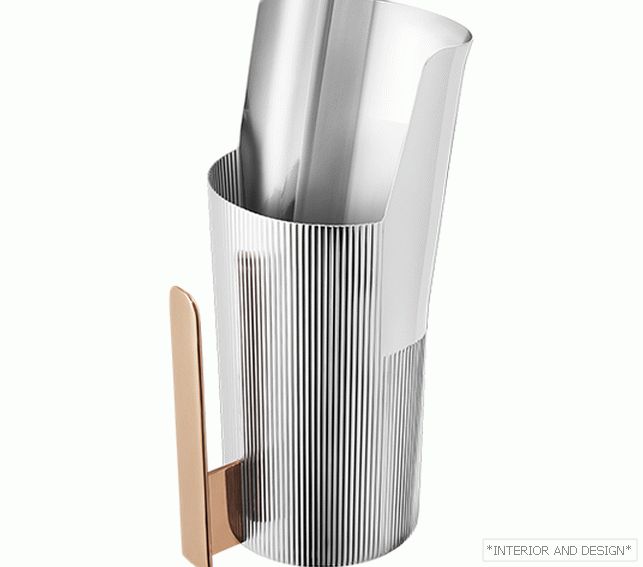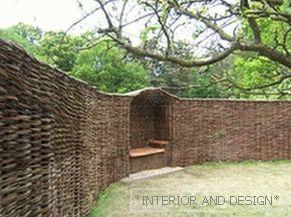 Wattle - great, fresh idea to give or a country house. Yes, yes, this is exactly the wicker fence - a mandatory attribute of rural landscapes of past centuries - a reminder of the carefree summer in the village. Wattle is a fence, woven from twigs (often willow) or branches (for example, hazel). A wicker hedge not only gives the house and the site authenticity - the fence can be a completely functional element of the yard.
Wattle - great, fresh idea to give or a country house. Yes, yes, this is exactly the wicker fence - a mandatory attribute of rural landscapes of past centuries - a reminder of the carefree summer in the village. Wattle is a fence, woven from twigs (often willow) or branches (for example, hazel). A wicker hedge not only gives the house and the site authenticity - the fence can be a completely functional element of the yard.
Content
- 1 Types of wicker
- 2 Material procurement
- 3 Weaving technique and installation
- 4 Subtleties and nuances
Types of wicker
Functions that will perform the fence, determine its height. What are wicker hedge?
- Low decorative wattle (up to half a meter). It can be a border for a flower bed or a bed.
- Wicker fence higher (up to 1 m) perfectly cope with the division of the yard into zones. For example, it is possible to enclose a garden swing with a weave, a table with benches, a brazier - the area where you relax. If there are domestic animals, the wicker fence will mark the territory where it is allowed to walk. Wattle can even become the main decoration of the yard, if you use it as a frame for climbing flowers.
- Tall, a two-meter long wicker fence will protect you from prying eyes of neighbors.
We should separately talk about willow wicker. They can be alive and non-living. It is known that if you do not remove the bark from the willow twigs, they will eventually begin to grow. At first, a living willow wicker will not protect as well as an inanimate. But it will take a couple of years, and it will grow, get stronger. Weaving a hedge is easy, because it consumes less material. Annual care also does not cause trouble: you just need to cut unnecessary twigs and properly direct the right ones. Needless to say that alive wicker fence is much more beautiful and more pleasant than ordinary.
Material procurement
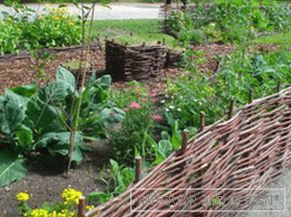 So you are determined to make a wattle by myself. Where to begin? First, decide what your wicker fence will be from. The traditional option - willow, hazel (hazelnut), grapevine. Harvesting raw materials is better from late summer to early fall. If none of this grows nearby, the branches of any fruit trees from your site will fit, and you will also prune at the same time. You can also use birch, poplar or aspen.
So you are determined to make a wattle by myself. Where to begin? First, decide what your wicker fence will be from. The traditional option - willow, hazel (hazelnut), grapevine. Harvesting raw materials is better from late summer to early fall. If none of this grows nearby, the branches of any fruit trees from your site will fit, and you will also prune at the same time. You can also use birch, poplar or aspen.
Carefully select branches; They have to:
- be elastic;
- no older than one year;
- have sufficient length (from 1.5 meters);
- thickness (1-3 cm).
Twigs may be of different colors from different trees. It will look even more original. Raw materials are ready, but do not rush to start work. In order for the rods to become even more elastic, they should be allowed to “lie down” in the water for a day. Barrel, old bath or pond - it does not matter. It is easier to work with flexible rods, and you can still create complex, unusual weaving.
Weaving technique and installation
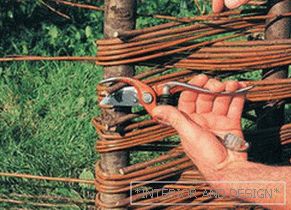 Basis the fence should be thicker stakes (3-5 cm in diameter), as an option - wooden cuttings from shovels, rakes
Basis the fence should be thicker stakes (3-5 cm in diameter), as an option - wooden cuttings from shovels, rakes
In the process of weaving the fence can "lead." To prevent this, the tops of stakes fix even planks. Before weaving the last, the top row of the strap will need to be removed. Weave a fence start from the ground, but remember that the lower branches should not touch it. To prevent the row from floating, fasten the rods on the uprights with wire. The same can be done with the top row.
Stretch each branch before vertical peg then behind. Get started from the thick end rod, but periodically change the direction of weaving, so that the thickness of the fence was uniform. When one branch is over, take the next one, but make sure that the tips do not end up on the front side. Alternate rods of different lengths - so the joints will not be noticeable.
The end of one branch can be stapled with the beginning of the other with wire. True, the craftsmen do not tie the ends of the rods with wire, and weave the same way as the basket, without fastening. To do this, you need experience and skill - with the wire still easier. The thicker the horizontal rows of rods will be, the stronger the fence will be. In addition, do not forget that the wood dries out over time, which means that the gaps between the branches will increase. If the bars are too thin, then the fence weave bundles rods. Thus, firstly, it turns out faster and easier, and secondly, a beautiful “chess” pattern of weaving is created.
Vertical wattle - This is a less common option. It is more like a palisade, because the rods are stuck into the ground vertically. If the wattle is short, then the support pins can be installed at a greater distance, compared to a horizontal fence. The main difference is that transverse poles - thicker rods - are fastened along the entire length of the fence. The first pole fixed at a distance of 20−30 cm from the ground. The remaining two - at equal intervals from each other.
Subtleties and nuances
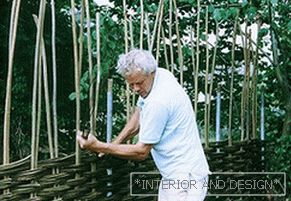 Scourge of reeds lasts a maximum of 4 years, the fence of hazel or willow - up to 10 years. I must say that the strength of the fence is largely dependent on the vertical stakes, which are supports. If they are hot-tipped at the ends or antiseptic, то не будут гнить. Идеальный вариант — обработать antiseptic весь забор. Если вертикальные стойки — это metal прутья, тонкие metal трубыили части арматуры, такой плетень еще надежнее.
Scourge of reeds lasts a maximum of 4 years, the fence of hazel or willow - up to 10 years. I must say that the strength of the fence is largely dependent on the vertical stakes, which are supports. If they are hot-tipped at the ends or antiseptic, то не будут гнить. Идеальный вариант — обработать antiseptic весь забор. Если вертикальные стойки — это metal прутья, тонкие metal трубыили части арматуры, такой плетень еще надежнее.
So that under the wicker fence does not stagnate waterso that the lower rows of rods do not rot, it would be good to make a small ditch under the fence. This trench needs to be filled with sand, which will play the role of drainage. Water will not linger, and easily seep through the sand. Sometimes they do this: they set the fence on a brick foundation, in fact a low brick fence that protects the lower bars from moisture. Practice shows that the fence established by the rules, serves the owners faithfully for more than a dozen years.
Once upon a time, to put a fence was under the power of each owner, it means that you can do it too. Do not doubt: a little effort - and now you are the owner of a stylish wicker fence. And the most important thing is that such a fence is made by your own hands, besides materials do not cost a penny.



